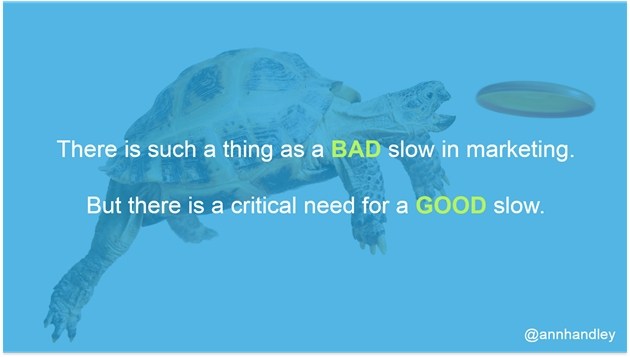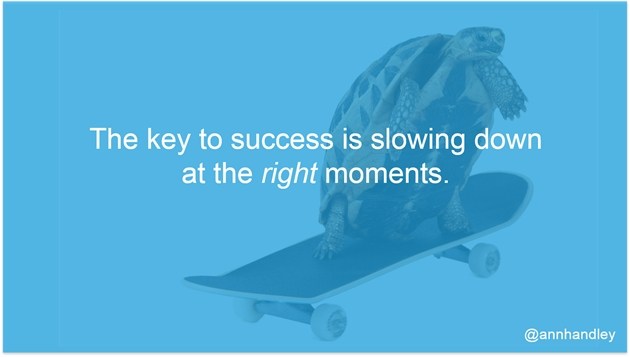This is the first article in an occasional series about the value of sometimes going As Slow As Possible in our fast-paced, always-on, agile, want-it-yesterday, mile-a-minute world. Yet, there is a critical need to slow down. Why? Because doing so allows you to achieve real results—faster.
Marketing is impatient.
We want more leads, more brand recognition, more social shares.
We want a fatter pipeline, fuller funnel, more ideas, and (often) more credit. And we want it now.
I get that. (I'm impatient, too.)
Yet, ironically, the companies that will have the biggest marketing wins this fall won't get there by going faster. Instead, they will get there by... wait for it... slowing down.
In our fast-paced, always-on, agile, want-it-yesterday, mile-a-minute world... there is a critical need to slow down. Why? Because doing so allows you to achieve real results—faster.
Or, rather, we need to identify those key moments when we need to slow down, because doing so allows the business to grow faster. (And better. And with more integrity.)
We need to invite slow to fuel fast.
The Value of Slow Marketing
Why would I suggest slowing down as a marketing strategy? Wasn't Ben Franklin spot-on when he said, "Remember that time is money"? Doesn't wisdom hold that when you slow down, you're roadkill?
Nope. The opposite is true.
Although… there is such a thing as a bad slow in marketing, but there is a critical need for a good slow, too.

To understand why, let's talk about Informatica.
This past spring, Informatica, a global data management company, wrote a book called The Marketing Data Lake with help from our friends at Velocity.
In it, authors (and Informatica execs) Franz Aman and Anish Jariwala detail how the company turned its marketing department upside down—transforming it from the poor relation of the "grown-up" departments of finance and sales into the stuff of B2B dreams: a powerful, accountable, data-driven contributor to the company's success.
How?
They joined all the company's data sets into one, neatly linking the data and storing it in something called the "data lake"—a kind of massive virtual repository. Think Amazon's main warehouse, except the "goods" are surfaced by wonderful, imaginative, useful queries—rather than workers tearing around on Segways.
Essentially, Informatica connected dots between various sales and marketing activities to see which actually contributed the dollars (and which sadly didn't). The company didn't just break down organizational silos: It had the silos hug it out and begin planning a life together.
I'm vastly simplifying. But suffice it to say that if Sales and Marketing Alignment were a sport in Rio, Informatica would've medaled.
The book documents how Informatica did it all lickety-split—in a 60-day sprint.
Insert Giant 'BUT'
But here's the thing about that 60-day sprint: authors Franz and Anish confessed that the 60-day sprint was possible only because of the prep work their team had done in the previous 18-24 months!
In other words, that fast 60-day sprint was possible only because of the slow, plodding, boring stuff Informatica didn't write a book about—the slog, the marathon.
That stuff was the boring basics: updating its marketing automation platform, ramping up its website and analytics platforms, polishing its content marketing program, and layering on Lattice Engines, a predictive scoring software solution.
Informatica had to slow down before it could move fast. Otherwise, it would have been an epic fail: a Data Lake so polluted and poisoned that the EPA would step in and shut it down.
Informatica slowed down at the right moment to make sure it was buff enough to hustle.
In other situations, at other companies, the slow marketing moments will be different. But, in my view, those critical slow marketing moments likely include the following six elements:
1. Honing customer empathy
"Empathy" is one of those words (like "transparency" and "authenticity") that is quickly earning a spot on the marketing buzzword Bingo card. It's overused and (often) abused.
But it's truly the heart of all great marketing. (And great writing.)
Have you slowed your roll to ensure that you are framing your marketing and your bigger story in a way that offers real value for the customer? Are you marketing programs based on real insight, or just hunches or (worse) clichés?
How: Do the slow work of hoarding data and research so you can do more than just put yourself in your audience's shoes: You should also be in their socks, shirts, pants, and hats. Heck, try on their skin... and walk around in that for a while. Because before all else, you need to have a deep understanding of your customers (and their problems, hopes, dreams). And that takes time.
2. Uncovering the Why
Marketing spends a lot of time on the what and the how (Should we create an infographic, video, podcast, Facebook Live? Should we distribute on social? Email? Ads in the yellow pages?)
(Just kidding on that last one.)
How: We need to put the Why before the What and the How. We need to go upstream with the rest of the leadership team and poke around in the brush a bit to flush out that Why.
In other words, we need to go deep into purpose and identity if we're going to ground our marketing and content strategy in something substantive—so that our programs can find a place within the context of what our customers care about.
Knowing the Why is what delivers content "for days," as my teenage daughter says.
3. Creating bigger, bolder, braver
Take the time to create marketing that doesn't feel like marketing. Write. Play. Experiment.
How: Create stuff that doesn't sound like everyone else's. Create stories that resonate. Create a unique tone of voice. (HAVE a tone of voice.)
Create things that engage. Create programs that feed our souls. Create a body of work you love (don't just "do your job.")
Is it weird that I'm starting every sentence with "create"?
That's intentional—because creativity isn't just nice-to-have in marketing. It's critical, and we need to put it front and center.
Packaged with creativity come pluck, nerve, spirit, and a bit of grit.
Embrace that, too. You've got this, boo.
4. Aligning the customer experience and journey
I'm trying to find a less corporate way to say this, because I'm allergic to corporate-speak. (And you should be, too, even if you are part of a corporation.)
How's this: Deliver an experience that your prospects and customers want to be part of. Delight them on the journey. (And afterward, too.)
This in particular can help you serve up a triple-scoop nopecone to things that distract or don't add value and that are just... unsatisfying and icky. Lose the tactics and activities that erode trust.
5. Measuring, interpreting, soliciting feedback
We need to be BFFs with the tech team and analytics brethren, because they can deliver what we need to help interpret and share our success and goals.
Listen to your own gut, too. Because that should also have a voice.
(Annnnd, weirdly, I'm now picturing a chatty gastrointestinal tract. That's not quite it: I'm talking about considering your own experience and sensibility here.)
6. Getting necessary tools and training
Marketing is developing quickly. Slow down to grok the new tools, techniques, platforms.
Up your game. Sharpen your skills. Challenge yourself.
How: What on this list feels awkward or scary to you? What did you immediately discount? Pay attention to that. Do the work. Get the training you need. Opportunities are bountiful.
Slow Fuels Fast
Incorporating a little sustainable slowness into our lives isn't a new idea. Carlo Petrini founded the Slow Food movement in Italy in 1986 as an alternative to fast food.
Later, Carl Honoré broadened the idea with his book In Praise of Slowness, in which he argued that our emphasis on speed erodes our quality of life, health, and productivity.
The notion of slow marketing isn't brand new, either. But as I'm defining it now, a slow marketing approach helps us strategically focus on what matters—in a way that, in the long term, accelerates growth. Do the slow slog now, in other words; put in the work, so that good stuff happens later. That way, we will sustain our programs, our companies, and ourselves.
Over the past year or so, I've been collecting stories of companies that have been slowing down at the right moments, and I've been documenting how those slow moments helped fuel fast growth. Last week at Content Marketing World (the annual Content Chrismakwanzaakuly and Homecoming!) I spoke about a few of them.
One thing these companies all share is that their biggest business wins were precipitated by having slowed down at the right moments.

I think we, too, need to uncover our own right moments for slowing down. In fact, I think it's critical, for three reasons:
- To sustain our marketing programs
- To sustain and elevate Marketing within our organizations
- To sustain ourselves as people—to be proud of what we create, and embrace our own value at our companies
Slow is more sustainable: for programs, for companies, for people.
Your turn: What am I missing? What "slow marketing moments" do we need to embrace? Or what slow moments have you already been part of?




